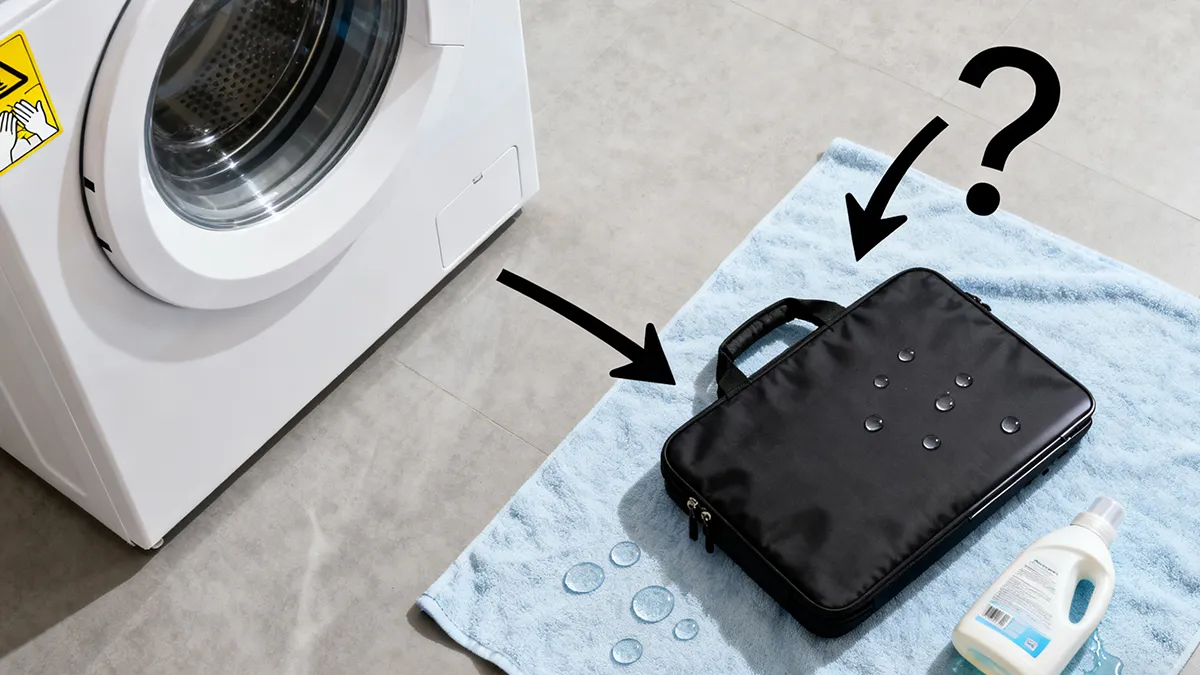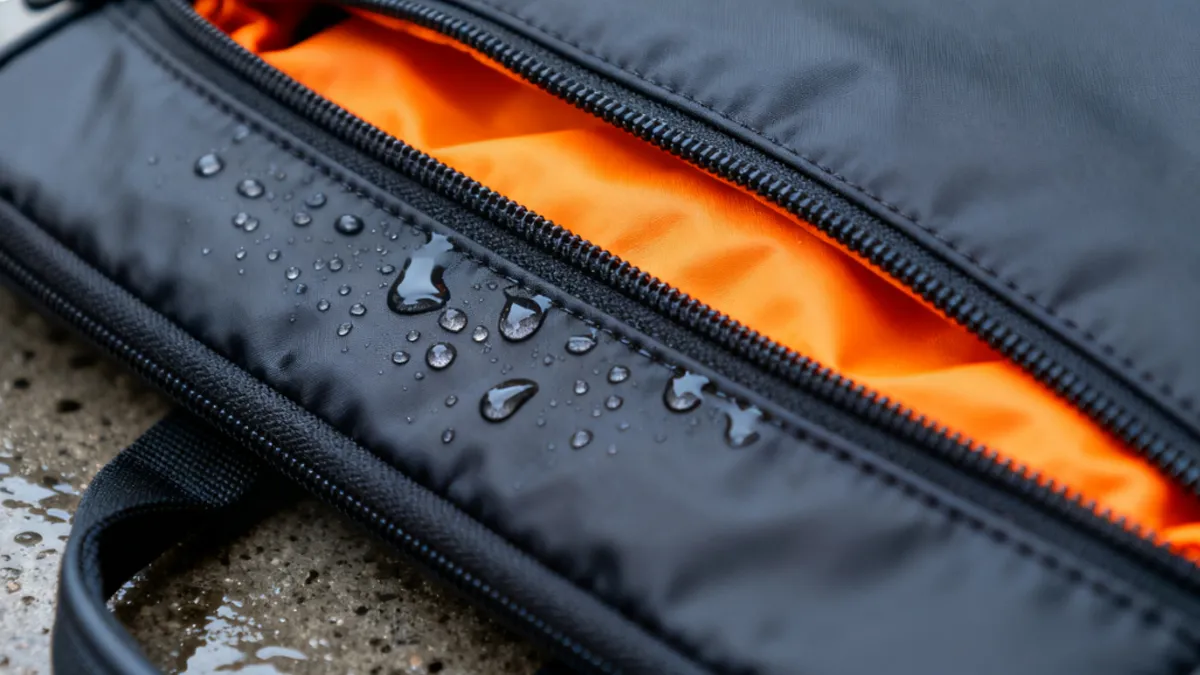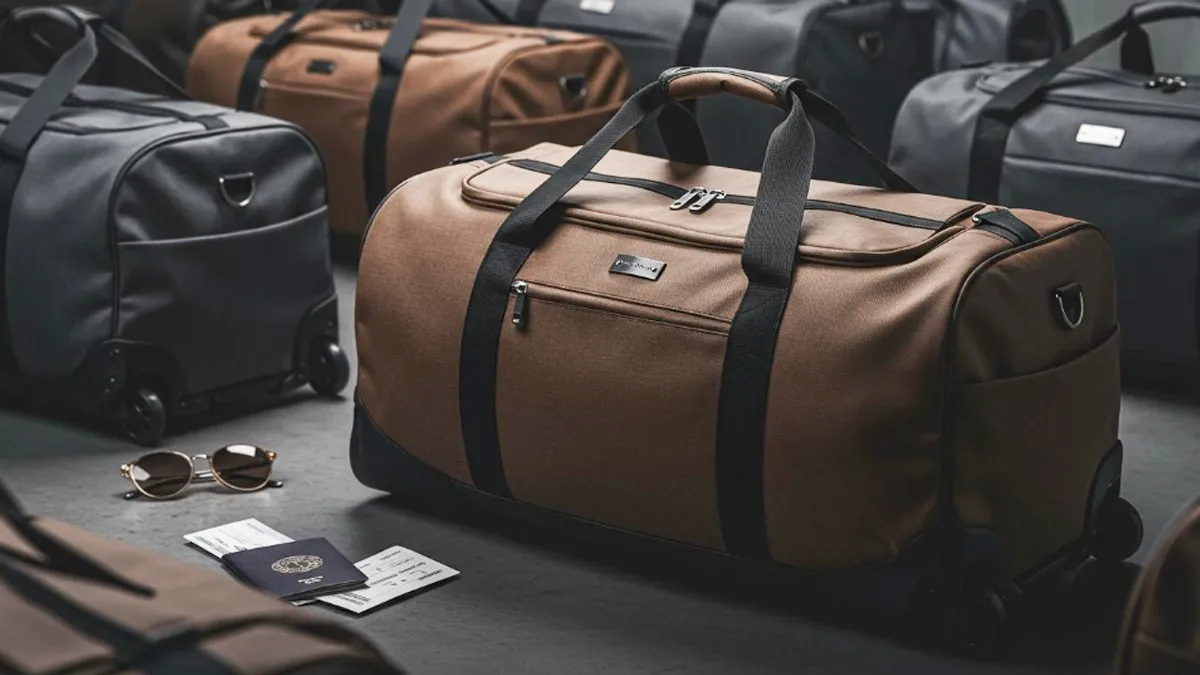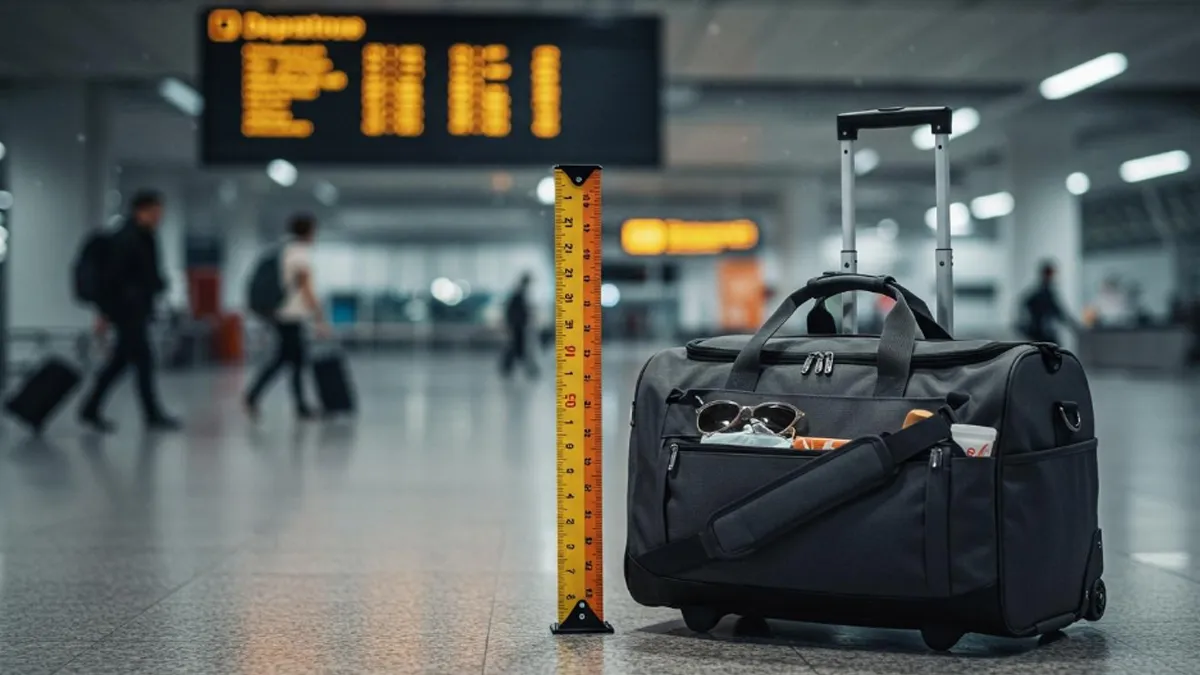
When you look for the perfect rolling duffle bag carry on size, you probably see a lot of numbers. Most airlines set their carry-on rules at 22 x 14 x 9 inches or 45 linear inches. Here’s a quick reference:
| Measurement Type | Maximum Size |
|---|---|
| Combined Size | 45 linear inches (114 cm) |
| Individual Size | 22” x 14” x 9” (56 cm x 35 cm x 23 cm) |
You want your carry-on to fit these limits so you can breeze through security. The right bag holds between 40 and 45 liters. This matters because you can pack enough for a few days without cramming. Always check your airline’s carry-on rules. Every airline has its own idea of what fits in the overhead bin. You don’t want surprises at the gate!
Key Takeaways
- Most airlines let you bring bags up to 22 x 14 x 9 inches or 45 linear inches. Always look at your airline’s rules before you pack.
- A rolling duffle bag should hold 40 to 45 liters for a weekend trip. This size gives you enough room without stuffing everything in.
- When you measure your bag, include the wheels and handles. They are part of the total size.
- Carry-on rules can be different for each airline. They can change between domestic and international flights. Use the smallest size rule if you have connecting flights.
- Budget airlines often let you bring smaller bags. They may also charge extra fees. Always read the details before you buy your ticket.
- Measure your bag after you pack it to make sure it fits. Bags that are too full can be too big.
- Packing cubes and rolling clothes help you use space better. They also keep your carry-on neat.
- Get to the airport early to find space in the overhead bins. If you board late, you might have trouble finding space.
Rolling Duffle Bag Carry On Size
Standard Dimensions
When you shop for a rolling duffle bag carry on size, you see a lot of numbers. Most airlines stick to the same rules for carry-on luggage sizes. The most common limit is 22 inches long, 14 inches wide, and 9 inches high. Airlines also use a total measurement called linear inches. You add the length, width, and height together. If the number is 45 or less, you are good to go.
Here’s a quick look at the most common limits:
| Size Limit | Description |
|---|---|
| 22” x 14” x 9” | Most common carry-on size for rolling duffle bags |
| 45 linear inches | Total dimension limit (length + width + height) |
You want your bag to fit these numbers. If your rolling duffle bag carry on size is too big, you might have to check it at the gate. That means extra fees and waiting at baggage claim. The right size helps you avoid these problems and makes your trip smoother.
Capacity in Liters
Capacity matters just as much as the measurements. You want enough space for your clothes, shoes, and travel gear. Most rolling duffle bag carry on size options hold between 40 and 45 liters. Some bags stretch up to 50 or 60 liters, but you need to check if they still fit the carry-on rules.
Here’s how rolling duffle bags compare to other carry-on luggage sizes:
| Type of Luggage | Volume (L) | Weight (kg) | Usable Volume Increase |
|---|---|---|---|
| Rolling Duffel | 60–120 | 3–5 | Up to 30% more |
| Suitcase | 40–90 | 2.5–4 | Rigid, less flexible |
For most trips, a rolling duffle bag carry on size with 40–45 liters gives you enough room. You can pack for a weekend or even a short business trip. If you pick a bag with more space, make sure it still fits the airline’s carry-on luggage sizes.
| Bag Type | Capacity (liters) |
|---|---|
| Rolling Duffel Bag | 50-60 |
A rolling duffle bag carry on size lets you use every inch. You can squeeze in extra items because the bag is flexible. Suitcases are more rigid, so you lose some space.
Linear Inches Explained
You might wonder what “linear inches” means. Airlines use this term to set limits for carry-on luggage sizes. Here’s how you figure it out:
- Add the length, width, and height of your bag.
- Include the wheels and handles in your measurement.
- Make sure the total is 45 inches or less.
Tip: Always measure your bag after you pack it. Sometimes, a stuffed bag gets bigger and goes over the limit.
Airlines use linear inches to keep bags small enough for overhead bins. If your rolling duffle bag carry on size goes over, you might pay extra or have to check your bag. You want to avoid surprises at the airport. Stick to the rules, and you will travel with less stress.
Airline Size Variations
Domestic vs International
You might think all airlines have the same carry-on rules, but that’s not true. Domestic flights in the United States usually stick to the standard carry-on size. You see the 22 x 14 x 9 inches rule almost everywhere. If you fly with a rolling duffle bag, you can expect your carry-on to fit in the overhead bin on most domestic flights.
International flights can surprise you. Some airlines in Europe or Asia use smaller bins. Your carry-on might need to be 21 x 13 x 8 inches or even less. You should always check the airline’s website before you pack your carry-on. If you travel between countries, you want to make sure your carry-on fits both airlines’ rules.
Tip: If you plan to connect from a domestic flight to an international one, pack your carry-on for the stricter size. That way, you avoid last-minute stress at the gate.
Budget vs Major Airlines
Budget airlines love to set their own rules for carry-on. You might see smaller carry-on limits or extra fees. Some budget airlines only allow one small carry-on, like a backpack or a tiny duffle. Major airlines usually let you bring a standard carry-on and a personal item.
Here’s a quick comparison:
| Airline Type | Carry-On Size Limit | Extra Fees? |
|---|---|---|
| Budget Airline | 18 x 14 x 8 inches | Often |
| Major Airline | 22 x 14 x 9 inches | Rare |
You want to read the fine print before you book. Budget airlines sometimes measure your carry-on at the gate. If your carry-on is too big, you pay a fee or check it. Major airlines give you more freedom with your carry-on, but you still need to follow their rules.
Policy Differences
Carry-on luggage size restrictions can change from airline to airline. Some airlines count wheels and handles in the measurement. Others only measure the main compartment. You need to measure your carry-on at home, including every part that sticks out.
You also see differences in weight limits. Some airlines let you pack your carry-on as heavy as you want. Others set a weight limit, like 15 pounds. If you travel with a rolling duffle bag, check both the size and the weight before you leave.
- Always check the airline’s website for the latest carry-on rules.
- Measure your carry-on after you pack it.
- If you fly with different airlines, use the strictest carry-on rule.
Note: Policies change often. You want to double-check your carry-on size before every trip.
You can avoid problems by planning ahead. When you know the rules, you pack your carry-on with confidence. You spend less time worrying and more time enjoying your trip.
Measuring Your Bag
Step-by-Step Guide
Measuring your rolling duffle bag for carry-on use sounds simple, but you want to get it right. If you measure wrong, your bag might not fit the carry-on rules. Here’s how you can measure your bag step by step:
- Place your rolling duffle bag on a flat surface. Make sure it is empty and zipped up.
- Use a tape measure. Start with the length. Measure from one end of the bag to the other.
- Next, measure the width. Go from one side to the other at the widest point.
- Measure the height. Start at the bottom and go to the top, including any bulges.
- Write down each number. Add them together to get the total linear inches. This number helps you know if your bag fits the carry-on size limit.
You want to measure your bag before every trip. Sometimes, you pack more and the bag gets bigger. Always check the size after you pack. If you use a soft-sided rolling duffle bag, it can stretch. Hard-sided bags keep their shape, but you still need to measure carefully.
Including Wheels and Handles
Many travelers forget to include the wheels and handles when measuring their rolling duffle bag for carry-on use. Airlines count every part of your bag. If you skip the wheels or handles, your bag might not fit in the carry-on sizer at the airport.
Tip: Always measure from the very bottom of the wheels to the top of the handle. Go from the farthest edge on one side to the farthest edge on the other. This way, you get the true size of your carry-on.
Soft-sided bags can squish a little, but wheels and handles do not. If your rolling duffle bag has a telescoping handle, make sure it is pushed down before you measure. Some handles stick out even when closed, so include them in your carry-on measurement.
Common Mistakes
You want to avoid the most common mistakes when measuring your rolling duffle bag for carry-on use. These mistakes can lead to problems at the airport. Here are some things travelers often get wrong:
- Forgetting to measure the handles and wheels, which are part of the carry-on size.
- Not checking the bag after using expansion zippers. Expanded bags can go over the carry-on limit.
- Misunderstanding how expandable features work. If you use them, your bag might not fit the carry-on rules.
- Only measuring the main compartment and skipping the outside pockets or bulges.
- Measuring before packing, then overstuffing the bag so it grows past the carry-on size.
If you use a soft-sided rolling duffle bag, remember it can change shape. Hard-sided bags stay the same, but you still need to check every part. Always measure your carry-on after you pack. This helps you avoid surprises at the airport.
Note: Every airline has its own carry-on rules. Double-check your bag’s size before you leave home. If you follow these steps, you can travel with your rolling duffle bag as a carry-on and skip the stress.
Wheeled Luggage Features
Collapsible Design
When you pick out wheeled luggage for your next carry-on, you want something that fits your needs and the airline’s rules. Many wheeled duffels come with a collapsible design. This means you can fold or flatten the bag when you do not need it. You save space at home or in your hotel room. Some bags even let you tuck them away in a closet or under a bed.
A collapsible design helps you adjust the size of your carry-on. If you do not pack much, you can compress the bag. If you buy souvenirs, you can expand it a little. This flexibility makes travel easier. You do not have to worry about a bulky bag taking up too much space. You also avoid the stress of trying to fit your bag into the overhead bin.
Tip: Always check if your wheeled luggage stays within the carry-on size when expanded. Some bags get too big when you fill them up.
Lightweight Materials
You want your carry-on to be light but strong. Wheeled luggage uses special materials to keep the weight down and the bag tough. Many brands use ripstop nylon or polyester. These fabrics resist tears and last a long time. The denier rating tells you how thick and strong the fabric is. A higher number means more durability, but sometimes more weight.
Here’s a quick look at popular rolling duffle bag carry-ons and their materials:
| Brand/Model | Material Type | Denier Rating | Durability Characteristics |
|---|---|---|---|
| REI Co-op Big Haul | 400D ripstop TPU nylon | 400D | Thinnest construction, lightweight |
| The North Face Base Camp Rolling Thunder | 1,000D polyester | 1000D | Very durable, nearly waterproof |
| Patagonia Black Hole | 900D ripstop polyester | 900D | Robust fabric, holds up well to rough use |
| Cotopaxi Allpa 65L | 840D nylon | 840D | Strong fabric, good for various conditions |
| General Note | Ripstop fabrics | N/A | Enhanced tear strength due to reinforcement yarns |
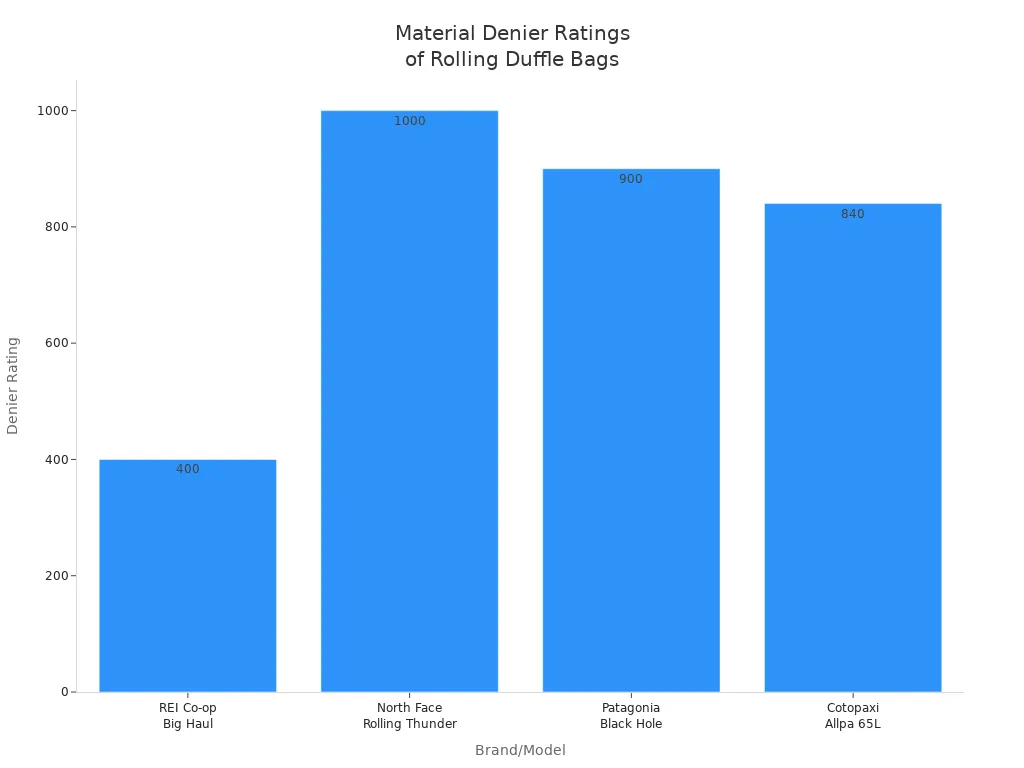
You want to pick wheeled luggage that balances weight and strength. A lighter bag means you can pack more without going over the carry-on weight limit. You also find it easier to lift your bag into the overhead bin.
Compartments
Organization matters when you travel with a carry-on. Wheeled luggage often comes with smart compartments. You get space-dividers, pockets, and zippered sections. These features help you keep your clothes, shoes, and gadgets in order. You do not have to dig through a messy bag at the airport.
Some rolling luggage has a rigid structure. This protects your things and keeps everything in place. Other bags, like luxury duffle bags, offer a wide opening and several compartments. You can pack bulkier items, but you need to plan how you use the space. The right compartments help you manage your carry-on limits and avoid overpacking.
Note: Always use the compartments to separate clean and dirty clothes or to keep your electronics safe. This makes your trip smoother and your carry-on easier to handle.
Wheeled luggage gives you mobility, organization, and practicality. You move through the airport with ease. You keep your things safe and easy to find. When you choose the right features, your carry-on becomes your best travel partner.
Carry-On Packing Tips
Smart Packing
Packing your carry-on can feel like a puzzle, but you can master it with a few simple tricks. Start by laying out everything you think you need for your trip. This step helps you see what you really use and what you can leave behind. You want to keep your carry-on light and organized.
- Use packing cubes to keep your carry-on neat. These cubes help you group clothes by outfit or type. You can also compress your clothes to save space.
- Try the army roll technique. Roll each piece of clothing tightly. This method saves space and keeps your carry-on looking tidy.
- Place bulky items, like shoes or jackets, at the bottom of your carry-on. Fill the middle with rolled clothes. Use the top for small items or things you need to grab quickly.
- Group your clothes by outfit. This makes it easy to find what you need without digging through your carry-on.
Tip: Always pack less than you think you need. Most travelers use only half of what they bring in their carry-on.
You want to maximize every inch of your carry-on. When you pack smart, you avoid overstuffing and keep your carry-on within airline limits.
Checking Policies
Every airline has its own rules for carry-on bags. You want to check these policies before you travel. Some airlines allow a larger carry-on, while others have strict size and weight limits. Always visit the airline’s website and look for the carry-on section.
- Check if the airline measures your carry-on with wheels and handles included.
- Look for weight limits. Some airlines weigh your carry-on at check-in or the gate.
- See if you can bring a personal item along with your carry-on. This could be a backpack or a small purse.
If you fly with different airlines, use the strictest carry-on rule. This way, you avoid last-minute surprises. You want your carry-on to fit every airline’s requirements.
Note: Policies can change. Always double-check your carry-on size and weight before each trip.
Gate Size Checks
Airlines often check carry-on bags at the gate. You want to make sure your carry-on fits in the sizer box. If your carry-on is too big, you may have to check it and pay extra fees.
- Measure your carry-on after you pack it. Bags can expand when full.
- Include wheels and handles in your measurement.
- Test your carry-on at home if you have a sizer box or use a tape measure.
If your carry-on fits at home, you can feel confident at the airport. You want to avoid the stress of repacking or paying extra fees at the last minute.
Tip: Keep your carry-on organized. If you need to remove items at the gate, you can do it quickly and easily.
Packing your carry-on the right way helps you travel with less stress. You move through security faster and enjoy your trip more.
Traveler Stories
Successes
You probably know that feeling when you walk onto a plane with your rolling duffle bag and it fits perfectly in the overhead bin. Many travelers share stories about how their carry-on made their trip easier. You can move quickly through the airport. You do not have to wait at baggage claim. You keep your things close and safe.
One traveler said, “I packed my rolling duffle bag as a carry-on for a week-long trip. I used packing cubes and rolled my clothes. Everything fit, and I never had to check my bag.” You can do the same. When you follow the size rules, your carry-on will fit on most flights. You avoid extra fees and save time.
Here are some tips from travelers who always succeed with their carry-on:
- Measure your rolling duffle bag before you leave home.
- Pack only what you need. Less is more.
- Use the compartments in your bag to stay organized.
- Arrive early so you get space in the overhead bin for your carry-on.
“I always double-check my carry-on size after packing. That way, I know I will not have problems at the gate.”
You can enjoy your trip more when your carry-on works for you. You move faster, feel less stress, and keep your things with you.
Challenges
Not every trip goes as planned. Sometimes, you face problems with your carry-on at the airport. You might have to check your rolling duffle bag at the gate. This can happen even if you follow the rules. Here are the most common reasons:
| Reason for Gate Checking |
|---|
| Bag exceeds the airline’s maximum carry-on size |
| Overhead bins are full, especially for late boarders |
You might pack your carry-on and think it fits, but after packing, it grows bigger. Some travelers forget to measure their carry-on after filling it up. Others use expansion zippers and do not realize their carry-on is now too large. If you board late, you may find no space left in the overhead bins. The airline may ask you to check your carry-on, even if it meets the size rules.
One traveler shared, “I thought my rolling duffle bag would fit as a carry-on. I packed souvenirs, and it became too big. At the gate, I had to check it and pay a fee.” You can avoid this by measuring your carry-on after packing and arriving early.
Here are some ways to handle these challenges:
- Always measure your carry-on after you finish packing.
- Avoid using expansion zippers unless you know your carry-on still fits.
- Try to board early so you get space for your carry-on.
- Keep important items in a small bag, just in case you must check your carry-on.
Remember, every airline has its own rules. Double-check before you travel. You want your carry-on to stay with you.
You can learn from these stories. When you plan ahead, your carry-on will help you travel with less stress.
You want your rolling duffle bag to meet the standard carry-on size and capacity. Most airlines set limits for carry-on bags, including wheels and handles. Always check your airline’s website for the latest carry-on rules. Here’s a quick look at some major airline carry-on limits:
| Airline | Maximum Dimensions (inches) |
|---|---|
| American Airlines | 22 x 14 x 9 |
| Delta | 22 x 14 x 9 |
| United | 22 x 14 x 9 |
| Alaska Airlines | 24 x 17 x 10 |
| JetBlue | 24 x 16 x 10 |
| Southwest | 24 x 16 x 10 |
| Frontier | 24 x 16 x 10 |
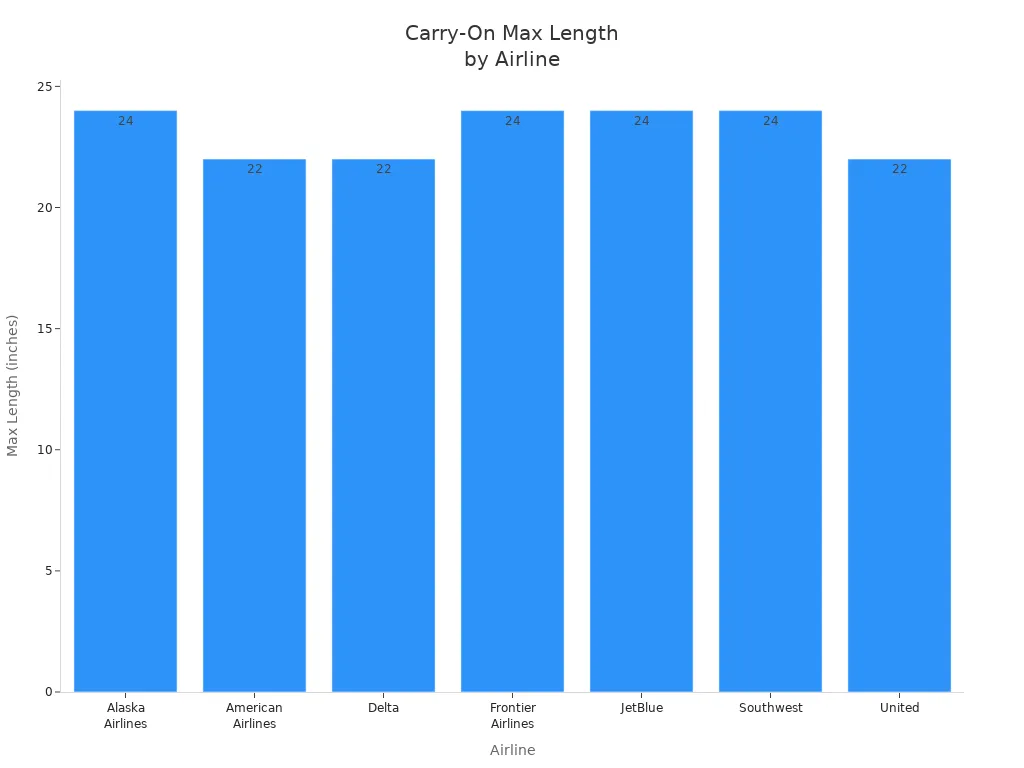
- Carry-on size restrictions can change, so double-check before you travel.
- Careful measuring and smart packing help you avoid carry-on problems at the airport.
- If your carry-on is too big, you may need to check it, which can cause delays or lost items.
Tip: Always measure your carry-on after packing and review your airline’s carry-on guidelines. You want a smooth trip, so stay prepared!
FAQ
What size rolling duffle bag can you use as a carry on?
Most airlines allow up to 22 x 14 x 9 inches or a total of 45 linear inches, which fits most overhead bins. Budget and regional carriers can be stricter. Before packing, confirm the size on your airline page and measure your bag once it is loaded.
Do wheels and handles count in the carry on size?
Yes. Measure from the bottom of the wheels to the top of the handle and across the widest point. Side handles, corner guards, and pockets all count. A soft duffle can compress a little, but plan for the full external size so you do not get flagged at the gate.
How much can you pack in a rolling duffle carry on?
Most 22 inch rolling duffles hold about 40 to 45 liters, enough for two to four days depending on season and shoes. Use packing cubes, roll knitwear, and place heavier items near the wheels for stability. Wear your bulkiest jacket and shoes to save space.
Can you use a rolling duffle bag on international flights?
Yes, but many international and low cost airlines set smaller limits, like 21 x 13 x 8 inches or specific weight caps. If you have connections, follow the strictest rule across the itinerary. Print or save the policy on your phone in case staff ask.
What happens if your rolling duffle bag is too big?
Agents can require a gate check and charge a fee. You will need to pick it up at baggage claim, which can delay you. To avoid this, measure after packing, test the bag in a home bin template if you have one, and avoid overstuffing exterior pockets.
Are rolling duffle bags better than suitcases for carry on?
Rolling duffles flex into tight bins and swallow odd shapes like boots or helmets. Hard side suitcases protect fragile items and keep clothes flatter. If you value flexibility and lighter weight, pick a duffle; if you carry breakables, a hard case wins.
How do you keep your rolling duffle bag organized?
Assign cubes for tops, bottoms, and underwear, and use a slim pouch for chargers and meds. Put frequently used items near the opening and dirty clothes in a separate sack. Cinch straps to keep the load from shifting, and keep documents in an exterior pocket.
Do airlines check the weight of rolling duffle carry ons?
Some do, especially outside the United States and with low cost carriers. Limits can be 7 to 10 kilograms. Weigh your packed bag at home, move heavy items to a personal item if allowed, and keep electronics accessible in case security asks you to remove them.

